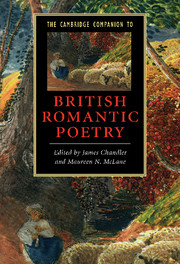Book contents
- Frontmatter
- Introduction: The companionable forms of Romantic poetry
- 1 The living pantheon of poets in 1820: pantheon or canon?
- 2 Romantic poetry and antiquity
- 3 Romantic meter and form
- 4 Romantic poetry and the standardization of English
- 5 Thinking in verse
- 6 Romantic poetry and the romantic novel
- 7 Wordsworth’s great Ode: Romanticism and the progress of poetry
- 8 Romantic poetry, sexuality, gender
- 9 Poetry, peripheries and empire
- 10 Romantic poetry and the science of nostalgia
- 11 Rethinking Romantic poetry and history: lyric resistance, lyric seduction
- 12 The medium of Romantic poetry
- 13 Romantic poets and contemporary poetry
- Index
- Series List
12 - The medium of Romantic poetry
Published online by Cambridge University Press: 28 November 2008
- Frontmatter
- Introduction: The companionable forms of Romantic poetry
- 1 The living pantheon of poets in 1820: pantheon or canon?
- 2 Romantic poetry and antiquity
- 3 Romantic meter and form
- 4 Romantic poetry and the standardization of English
- 5 Thinking in verse
- 6 Romantic poetry and the romantic novel
- 7 Wordsworth’s great Ode: Romanticism and the progress of poetry
- 8 Romantic poetry, sexuality, gender
- 9 Poetry, peripheries and empire
- 10 Romantic poetry and the science of nostalgia
- 11 Rethinking Romantic poetry and history: lyric resistance, lyric seduction
- 12 The medium of Romantic poetry
- 13 Romantic poets and contemporary poetry
- Index
- Series List
Summary
“The recognition that every form is a form-in-a-medium dates back to romanticism.”
Niklas Luhmann, Art as a Social SystemPreliminaries
Among the questions confronting students of literature in the twenty-first century is the place of the word - and of “letters” - in the era of electronic media. Should university departments of “English” be subsumed into the more general category of “Media Studies”? Are authors mere “content providers” for owners of iPods and computers? Should poetry be shelved next to other forms of audio entertainment in media megastores? In the context of the Age of Information, the so-called “Age of Wordsworth” seems to retreat into the distant past, and to make the concept of a Romantic revolution in poetic language and form seem remarkably quaint. This chapter begins from the quite different premise that Romantic poetry is both strikingly illuminated by, and capable of illuminating, our multi-mediated situation. We suggest, in fact, that the study of Romantic poiesis - poetic making in its broadest sense - belongs as much to media history as to literary scholarship. Defined by its relation to print culture even when it existed in and insisted on oral and manuscript forms, Romantic poetry might even serve as a synonym for what we mean by multimedia. For decades, media theorists and historians have grappled with the impact of new media on our bodies, imaginations, and sensoria; inasmuch as man is the “learning, creating, and communicating being,” new technologies for communication have put pressure on our ideas of “Man” and his or her imaginative ventures, not least poems.
- Type
- Chapter
- Information
- The Cambridge Companion to British Romantic Poetry , pp. 239 - 262Publisher: Cambridge University PressPrint publication year: 2008
- 21
- Cited by



